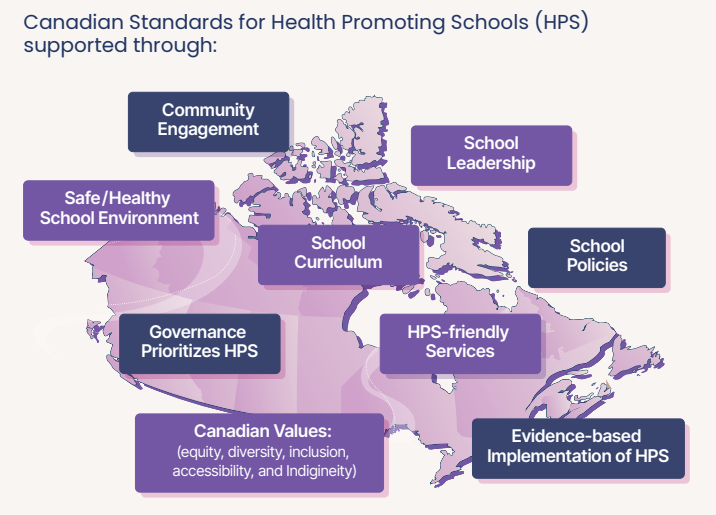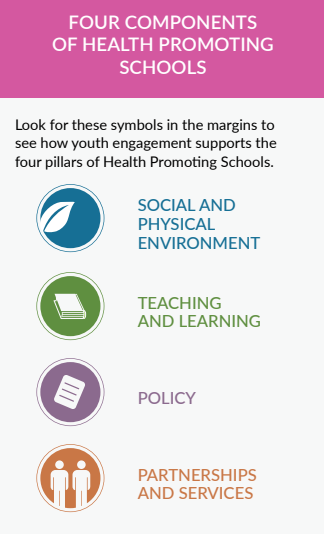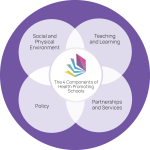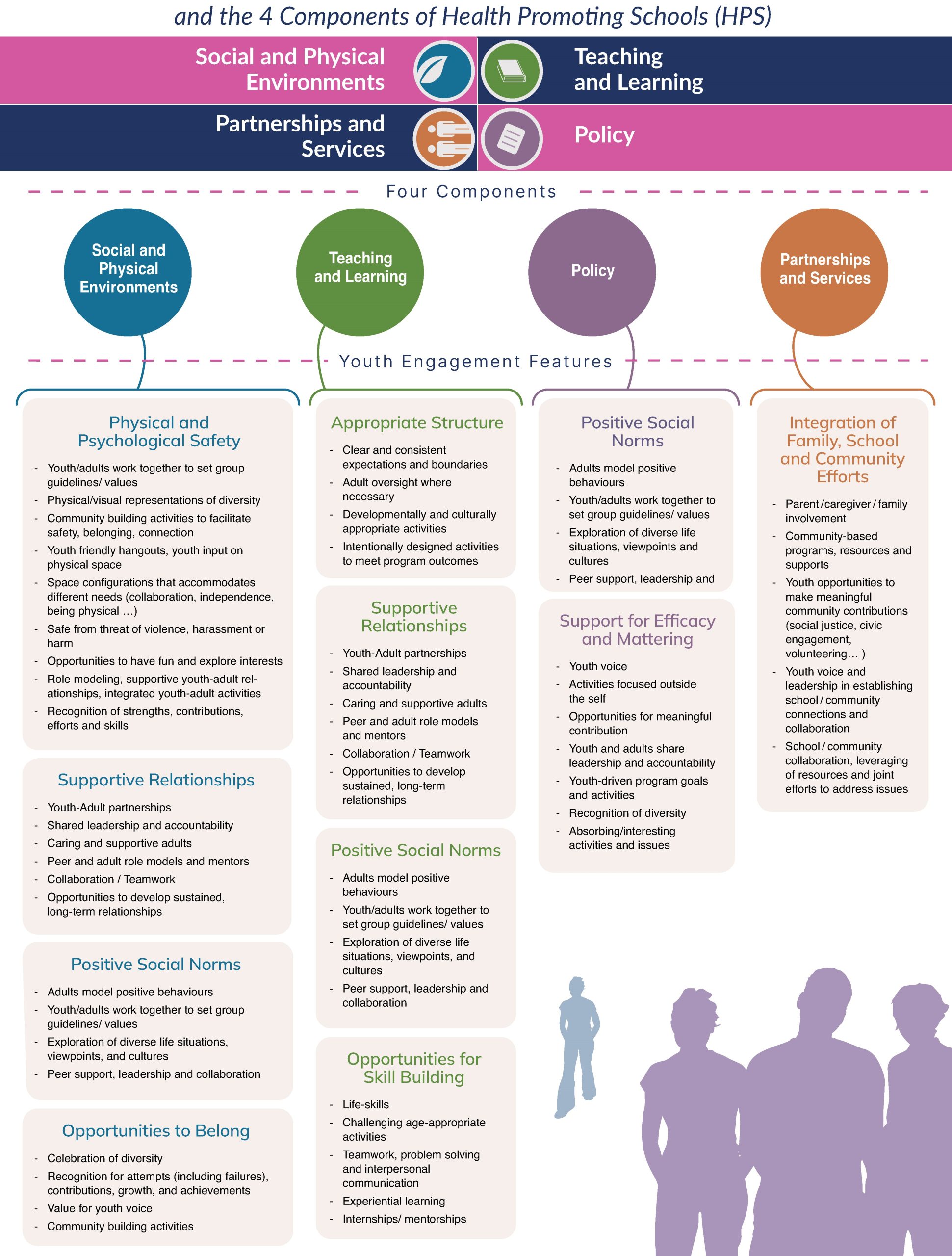Toolkit Background
The Pan-Canadian Joint Consortium for School Health is a partnership of Canada’s federal, provincial and territorial governments except Québec. Established in 2005, it brings together key representatives from each jurisdiction’s health and education ministries/departments and helps them to work more closely together to support Health Promoting Schools (HPS). The JCSH addresses its efforts to advance HPS by sharing the strengths and challenges facing everyday school community. The JCSH recognizes how important it is for the health and education sectors to work together to improve student achievement across Canada.
To guide the work of this collaboration, the JCSH promotes four inter-related components that must be in place (and supported by a number of stakeholders) to realize HPS: (i) teaching and learning, (ii) social and physical environments, (iii) policy and (iv) partnerships and services.
Recognizing youth engagement as a culture and practice that can enhance health promoting schools, the JCSH reconnected with the Students Commission of Canada to revise this Youth Engagement Toolkit. The Students Commission was founded in 1991 with a mission to support young people to put their ideas for improving themselves, their communities and their world into action. In 2000, the Students Commission established the Centre of Excellence for Youth Engagement, which networks academics, youth organizations and young people to provide research, evaluation and training to improve youth programs and youth engagement in Canada.
Student engagement, a critical factor for effective learning, has become a key focus in educational research. Student engagement is the dedication, enthusiasm and diligence students demonstrate in pursuing knowledge, encompassing behavioural, affective and cognitive aspects1. That is, student engagement includes factors such as attendance and class participation, interest, affinity, sense of community, emotional connection with the learning environment and educators, concentration and attention towards study materials, effort to exceed expectations and their enjoyment of intellectual challenges. Hybrid learning, which combines face-to-face and online instruction, is seen as an effective approach to enhance engagement since it provides students with both the in-person connection of face-to-face learning and the autonomy of online learning.
Both research and experience have demonstrated that youth engagement and youth-adult partnerships can change a young person’s life for the better.1 The Students Commission’s core values: Respect, Listen, Understand and Communicate™ and processes inform its work. This toolkit draws on practical examples and illustrations from the programs of The Students Commission, its partners and the latest in research and evaluation from the Centre of Excellence for Youth Engagement.
Why is Youth Engagement Important?
It’s simple. Youth engagement (YE) can and does change lives. This eBook is designed to give you insight into the “how” and “why” of YE, as well as the outcomes you can expect. Youth engagement recognizes young people’s right to participate in decisions that impact them and acknowledges the great skills and strengths they bring to the table. It injects young people as valued stakeholders into creating effective and inclusive policies, programs and environments.
Youth engagement is especially crucial in the post-pandemic world for several reasons:
Reduces Social Isolation: Many young people experienced heightened social isolation during the pandemic due to lockdowns and social distancing measures. Engaging them in activities and communities helps counteract these feelings of isolation, providing them with meaningful interactions and a sense of belonging.
Promotes Social Connection: Active engagement fosters stronger connections among peers and with supportive adults. This helps build a network of relationships that can offer emotional support, friendship and a sense of community, which are vital for mental and emotional well-being.
Supports Mental Health: Engaging youth in positive and constructive activities can alleviate stress and anxiety, which have been prevalent among young people during and after the pandemic. It also encourages the development of coping skills and resilience.
Encourages Personal Growth: Through engagement, young people have opportunities to develop new skills, interests and talents. This growth can enhance their self-esteem, sense of purpose and readiness to contribute positively to their communities.
Strengthens Community Bonds: When youth are actively involved, they contribute to and benefit from a stronger, more connected community. This mutual support helps communities recover and thrive in a post-pandemic world.
What is Youth Engagement?
To see “What is Youth Engagement” video click above.
Effective youth engagement leads to positive outcomes for youngpeople at three levels:
- The Individual level: e.g., increased personal skills, healthy choices and sense of identity.
- The Social level: e.g., stronger positive connections with friends and adults and a larger support network.
- The System level: e.g., greater civic engagement, policies and programs responsive to the needs of young people and new creative ways to govern.
For instance, flexibility in the academic schedule, practicing to be responsible for one’s own learning and maintaining self-discipline, time-management skills and availability of lecture records for future reference have been reported as the individual level positive outcomes of virtual youth engagement2.
Please see the Literature Review3 for a detailed overview of the research and outcomes related to youth/student engagement.
Youth Engagement and Health Promoting Schools
Youth engagement is an integral component of Health Promoting Schools4 (HPS) and an evidence based strategy to achieve positive health outcomes and enhance student achievement. When young people are engaged in decision-making, they feel connected to their school environment5 and community6, they build relationships with their peers and adults6,7 and they learn new skills8. They are more likely to make healthy decisions, have healthy behaviors and take fewer unhealthy risks9. They are also more likely to do well in school7,10 and continue learning throughout their lifetime11.
HPS requires the involvement of the whole school and community; everyone is needed and everyone has something valuable to contribute. This is done when
the school community addresses priority actions and initiatives through four
distinct, but inter-related components:
- Teaching and Learning
- Physical and Social Environment
- Policy
- Partnerships and Services
The purpose of HPS is to bring about a school climate that supports the best possible health and learning outcomes. Young people can contribute meaningfully to all levels and activities of school health – from teaching and learning, to improving the physical and psychosocial environment, to decision-making and healthy school policy development, to partnerships with parents/guardians, the wider community and services.
To access “Health Promoting Schools” video click above.
DIGITAL COLLABORATION
Many students and educators have transitioned to collaborating and addressing priority actions in a hybrid fashion, both virtually and in-person. Digital collaboration combines processes and tools to facilitate communication and interaction between educators and students. This is accomplished through the utilization of various software platforms and tools. The interactivity provided by technological tools such as Microsoft Teams facilitates collaborative learning through meaningful interactions among course participants, which also aligns with educational theories that emphasize the social nature of learning14. Therefore, these tools allow students to work together on activities and projects to achieve a deeper understanding in a framework of effective communication where their social skills are developed and their prior knowledge is leveraged. Interactive teaching methods are fundamental in preparing students with the necessary professional skills to effectively apply their theoretical knowledge to practical, real-world situations15. Digital collaboration promotes connectivity between students and teachers, thereby increasing efficiency and promoting a sense of community online.
Key Features of Youth Engagement
Click to Enlarge
”Youth know what is meaningful and valuable to their community. Even if you are just a few years removed, you will not understand their reality like they do.
Lynn Ann Duffley, NB
”I learned that the government of Canada is interested in the opinions of young people and that everyone has different and valuable opinions.
Youth Participant, HBSC Consultation
”I feel amazing because of this conference. It was life changing.
Youth Participant
”I am completely sold on the idea that youth engagement in policy development needs to be
Policy Maker, Ministry of Education, ON
done early, it needs be done often and it needs to be student lead.
Student-led Research Inquiry
Tricia Labrie, Health Promoting Schools Coordinator, in Central Okanagan BC,
co-developed the Got Heath? pilot student engagement program. Got Health? is a student-led inquiry program which engages young people in creating healthy school environments. It was piloted in 8 schools in the interior of BC. In addition to creating opportunities for students to assess their schools through photo voice and lead research projects, the program provides training sessions for adults on how to work effectively with youth. The program is based on the comprehensive school health framework. “Despite the different focuses of the inquiries (e.g. after school physical activities, breakfast programs, smoking cessation, etc.), they were all about connectedness, belonging and contribution,” Tricia recalls.
Fundamental Elements to Virtual Youth Engagement
The conceptual framework Community of Inquiry (CoI), used to enhance the
quality of online learning experiences, defines three fundamental elements:
social presence, teaching presence and cognitive presence12. Social presence denotes the ability of learners and instructors to establish a sense of community and connection in the virtual environment. Cognitive presence refers to developing students’ critical thinking and inquiry skills. While teaching presence is the most crucial component given that it integrates the social and cognitive presences to provide authentic online educational experiences13, it refers to the development and implementation of learning activities by the instructor. According to the CoI model, the interaction among these components is essential for fostering a rich and effective online learning experience.



